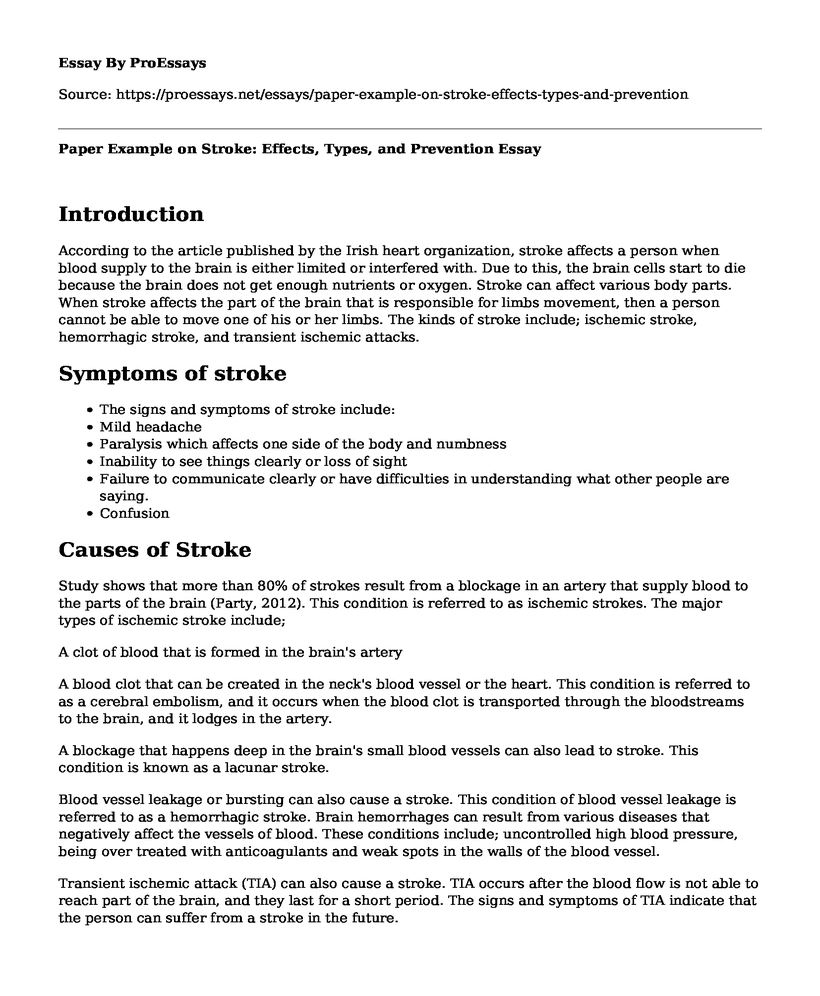Introduction
According to the article published by the Irish heart organization, stroke affects a person when blood supply to the brain is either limited or interfered with. Due to this, the brain cells start to die because the brain does not get enough nutrients or oxygen. Stroke can affect various body parts. When stroke affects the part of the brain that is responsible for limbs movement, then a person cannot be able to move one of his or her limbs. The kinds of stroke include; ischemic stroke, hemorrhagic stroke, and transient ischemic attacks.
Symptoms of stroke
- The signs and symptoms of stroke include:
- Mild headache
- Paralysis which affects one side of the body and numbness
- Inability to see things clearly or loss of sight
- Failure to communicate clearly or have difficulties in understanding what other people are saying.
- Confusion
Causes of Stroke
Study shows that more than 80% of strokes result from a blockage in an artery that supply blood to the parts of the brain (Party, 2012). This condition is referred to as ischemic strokes. The major types of ischemic stroke include;
A clot of blood that is formed in the brain's artery
A blood clot that can be created in the neck's blood vessel or the heart. This condition is referred to as a cerebral embolism, and it occurs when the blood clot is transported through the bloodstreams to the brain, and it lodges in the artery.
A blockage that happens deep in the brain's small blood vessels can also lead to stroke. This condition is known as a lacunar stroke.
Blood vessel leakage or bursting can also cause a stroke. This condition of blood vessel leakage is referred to as a hemorrhagic stroke. Brain hemorrhages can result from various diseases that negatively affect the vessels of blood. These conditions include; uncontrolled high blood pressure, being over treated with anticoagulants and weak spots in the walls of the blood vessel.
Transient ischemic attack (TIA) can also cause a stroke. TIA occurs after the blood flow is not able to reach part of the brain, and they last for a short period. The signs and symptoms of TIA indicate that the person can suffer from a stroke in the future.
According to Wolf & et al (2011), stroke has risk factors such as old age, race, diabetes, high cholesterol, and history of the family which include stroke or transient ischemic attack, high blood pressure, use of illegal drugs or smoking cigarettes (Wolf & et al, 2008), physical inactivity and being overweight.
Prevention of Stroke
According to Prevention (2014), the Prevention of stroke includes the following.
- High blood pressure control
- Reducing the amount of cholesterol and saturated fat in the diet (Goldstein & et al., 2008)
- Stop the use of tobacco, limit the consumption of alcohol and avoid illegal drugs
- Maintain a healthy weight
- Diabetes control
- Exercising regularly and eat a diet rich in fruits and vegetables.
- Prevention medications include anti-platelet drugs and anticoagulants
Stroke can be treated using clot-busting drugs thrombolysis, which uses effective blood thinners to break down the blood clot (ATLANTIS, 2014). Some people do not recover from a stroke, and others die due to stroke. Early diagnosis and treatment of stroke can help to save lives and also avoid severe disability (Marler & et al., 2010).
Conclusion
Stroke is a condition that affects everyone regardless of any factor involved. Stroke is a condition that affects a person when blood supply to the brain is either limited or interfered with. This condition makes a person to be paralyzed one side of the body. The treatment of stroke depends on the patient because some patients recover from a stroke while others lose their lives. Early diagnosis of stroke can help to manage the condition to avoid further effects.
Works Cited
ATLANTIS, T. (2014). Association of outcome with early stroke treatment: pooled analysis of ATLANTIS, ECASS, and NINDS rt-PA stroke trials. The Lancet, 363(9411), 768-774.
Goldstein, L. B., Amarenco, P., Szarek, M., Callahan, A. 3., Hennerici, M., Sillesen, H., ... & Welch, K. M. A. (2008). Hemorrhagic stroke in the stroke prevention by aggressive reduction in cholesterol levels study. Neurology, 70(24 Part 2), 2364-2370.
Marler, J. R., Tilley, B. C., Lu, M., Brott, T. G., Lyden, P. C., Grotta, J. C., ... & Haley, E. C. (2010). Early stroke treatment associated with better outcome: the NINDS rt-PA stroke study. Neurology, 55(11), 1649-1655.
Party, I. S. W. (2012). National clinical guideline for stroke (Vol. 20083). London: Royal College of Physicians.
Prevention, S. (2014). Guidelines for medical treatment for stroke prevention. Ann Intern Med, 121, 555.Stroke Prevention in Atrial Fibrillation Investigators. (2011). Stroke prevention in atrial fibrillation study: final results. Circulation, 84(2), 527-39.Trialists'Collaboration, S. U. (2013). Organised inpatient (stroke unit) care for stroke. Cochrane database syst rev, 9(9).
Wolf, P. A., Abbott, R. D., & Kannel, W. B. (2011). Atrial fibrillation as an independent risk factor for stroke: the Framingham Study. Stroke, 22(8), 983-988.
Wolf, P. A., D'Agostino, R. B., Kannel, W. B., Bonita, R., & Belanger, A. J. (2008). Cigarette smoking as a risk factor for stroke: the Framingham Study. Jama, 259(7), 1025-1029.
Cite this page
Paper Example on Stroke: Effects, Types, and Prevention. (2023, Jan 26). Retrieved from https://proessays.net/essays/paper-example-on-stroke-effects-types-and-prevention
If you are the original author of this essay and no longer wish to have it published on the ProEssays website, please click below to request its removal:
- Essay Example on Causes and Effect of Attention Deficit Hyperactivity Disorder
- An Argumentative Essay on Vaccine
- The Five Patterns of Knowledge - Paper Example
- Essay Sample on Nurse-Patient Ratios: Achieving Improved Care & Economic Benefits
- Essay Example on Genes & Environment Interact: Impact on Org. Development & Behaviour
- Essay Example on Engaging Students With Special Needs: Strategies for Active Learning
- Annotated Bibliography Sample on Medication Errors: Understanding and Avoiding Adverse Effects







